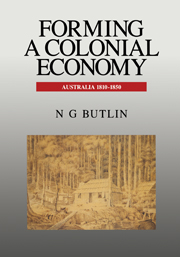Book contents
- Frontmatter
- Contents
- List of Tables
- List of Figures
- Acknowledgements
- Part I Forming an Economy
- Part II The Colonial Peopling of Australia: 1788–1850
- Part III Public Funding of Colonial Development: 1788–1850
- Part IV The Colonial Australian Economy 1810–1840—A Historical, Statistical and Analytical Account
- 11 Summary and Questions
- 12 Towards a Private Market Economy in Australia: 1810–40
- 13 Structural Adjustment and Development: 1810–40
- 14 Growth Performance: 1810–40
- 15 Instability and Economic Fluctuations with Special Reference to the Depression of the 1840s and Recovery
- Bibliography
- Appendixes
- Index
15 - Instability and Economic Fluctuations with Special Reference to the Depression of the 1840s and Recovery
from Part IV - The Colonial Australian Economy 1810–1840—A Historical, Statistical and Analytical Account
Published online by Cambridge University Press: 04 August 2010
- Frontmatter
- Contents
- List of Tables
- List of Figures
- Acknowledgements
- Part I Forming an Economy
- Part II The Colonial Peopling of Australia: 1788–1850
- Part III Public Funding of Colonial Development: 1788–1850
- Part IV The Colonial Australian Economy 1810–1840—A Historical, Statistical and Analytical Account
- 11 Summary and Questions
- 12 Towards a Private Market Economy in Australia: 1810–40
- 13 Structural Adjustment and Development: 1810–40
- 14 Growth Performance: 1810–40
- 15 Instability and Economic Fluctuations with Special Reference to the Depression of the 1840s and Recovery
- Bibliography
- Appendixes
- Index
Summary
Introduction
The Australian economies of New South Wales and Van Diemen's Land were expanding geographically in terms of aggregate activity at an enormous pace after 1812. To these were added, in 1828, the tiny Swan River settlement and the beginnings of the South Australian corporate undertaking in 1836, combined with the surge of expansion at Port Phillip from 1835, initially as an adjunct of NSW. At an average population and workforce growth rate compounded in excess of 10 per cent per annum, it would be surprising if a high order of stability could have been sustained. Curiously, Van Diemen's Land, with by far the fastest rate of expansion, indeed seems to have achieved a relatively stable expansion path, particularly by comparison with NSW. The risk of instability in rapid expansion was accentuated by the novelty of the whole Australian development project, the underlying importance of adapting to a new rural environment, exposure to climatic variations and other farming problems, variations in British policy in relation to human and physical capital.
The speed of expansion and its continued geographical spread led to a severe check in the form of the so-called ‘depression of the 1840s’. This was the approximate point at which Australia was experiencing its first major halt to long-run expansion. The depression of the 1840s stands in a line, historically, with that in ‘the 1890s’ and in ‘the 1930s’.
- Type
- Chapter
- Information
- Forming a Colonial EconomyAustralia 1810–1850, pp. 223 - 226Publisher: Cambridge University PressPrint publication year: 1994



